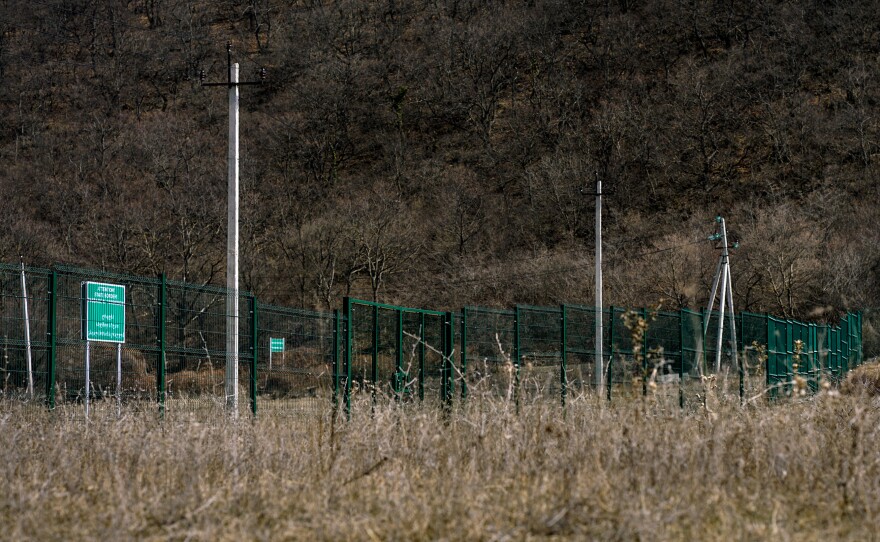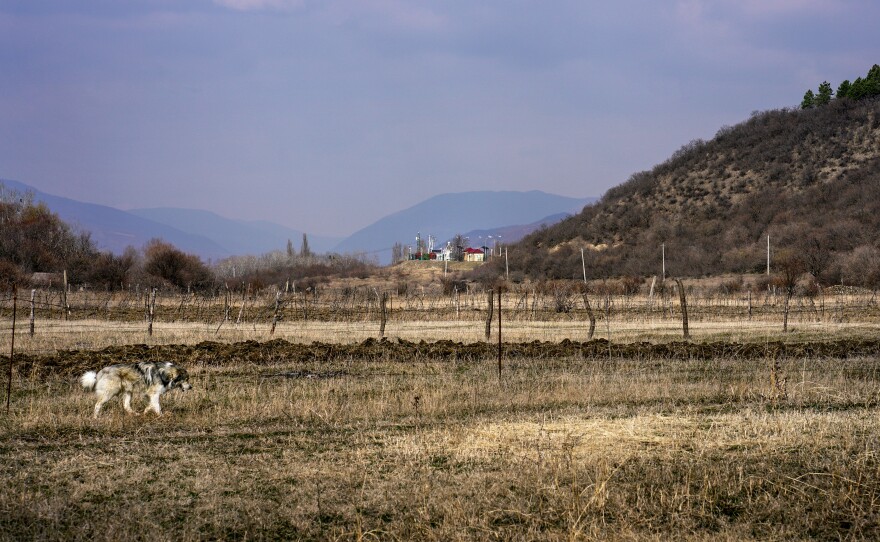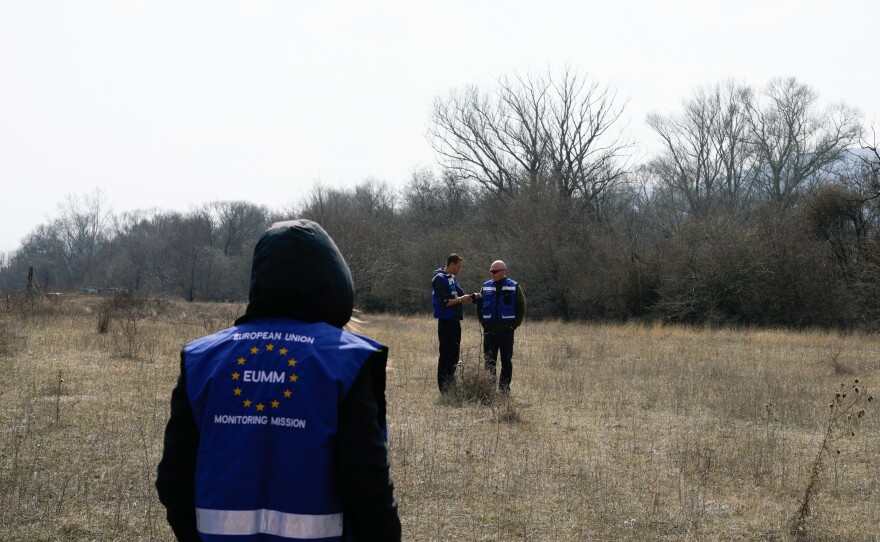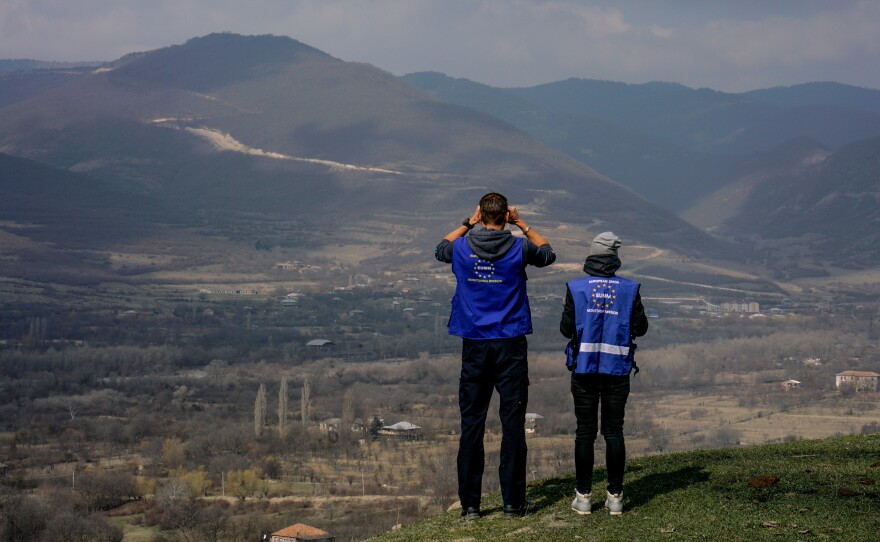


Much attention has been paid in recent years to Russia's annexation of Crimea. But Ukraine is not the only place where Russia has exploited ethnic conflicts and disputed territories along its borders.
In the foothills of the Caucasus mountains, 2,500 feet up, Russia is steadily building what it says is a new international border. It's marked by a hodgepodge of barbed wire fences, large green signs, hastily dug trenches and well-manned checkpoints. Villages are divided by it and people are regularly thrown in jail for crossing it.
But according to most of the world, this border doesn't exist, and neither does the land it defines — the Republic of South Ossetia.
South Ossetia, a region roughly the size of Rhode Island with a population of some 40,000 ethnic Ossetians, declared its independence from Georgia in 1990, following the breakup of the Soviet Union. After a two-year war and an imperfect ceasefire, South Ossetia operated for nearly two decades as a self-declared independent state, with periodic flare-ups in fighting.
The region had its own government, but no enforced border. That changed in 2008.
In August of that year, Georgia launched an offensive to retake control of the breakaway region. In a war that lasted five days, Russia responded by invading and occupying South Ossetia. Then it recognized it as a sovereign state. Most of the rest of the world, including the United States and Europe, declined to follow suit. The only other countries that recognize South Ossetia are Nicaragua, Venezuela and Nauru.
Since then, despite a tenuous peace, the conflict remains unresolved, as Russia has slowly been turning the previously theoretical borders of South Ossetia into real lines on the ground.
The village of Khurvaleti, home to perhaps 700 people, is literally split in two by the new boundary — one side in Russian-controlled territory, the other under Georgian control.
"To start with, this wasn't a great village," said Givi Khuroshvili, a lifelong, middle-aged resident sitting with friends on a park bench in the center of town. "Now, after this conflict, everyone tries to avoid it," he says.
The village, explains music teacher Zizi Kurmashvili, used to be prosperous — people had huge apple, peach and plum orchards and there was a thriving market. Now, she says, Russia has stolen their land and their water, and people can't make any money.
Concertina wire runs through the center of Khurvaleti, dividing neighbor from neighbor. Russian border guards are stationed in bunkers overlooking the town from three sides.
"If you go up on the mountain after your cows or your animals, they take you to Tskhinvali," Khuroshvili said, referring to the de facto capital of South Ossetia, where those arrested for crossing the boundary line are typically imprisoned — most frequently for several days, but sometimes for much longer.
The Georgia State Security Service reports that in 2016 alone, 134 people were detained by Russian border guards and thrown in jail for crossing the boundary from Georgia to South Ossetia.
But if the consequences of crossing the line are very clear, it is not at all clear where that line is. Farmers along the boundary have gone to bed one night thinking their fields and orchards were in Georgia, only to wake up and discover fencing and trenches indicating otherwise. New green signs announcing the presence of a South Ossetian "state border" occasionally pop up in places previously understood to be well within Georgian territory.
For now, the boundary is, effectively, wherever Russia says it is. Russia claims it is following old Soviet military maps defining the border of South Ossetia, which was considered a province of sorts in Soviet times. But maps defining that territory are unpublished.
"If you have a so-called border in the middle of a village, in the middle of the orchards, it creates huge problems for the local community, for the society," says Tomasz Szablowski, a monitor for the European Union.
Several times a week, EU monitors visit a small Russian checkpoint just outside the village of Odzisi, along what has become Georgia's de facto northern border, to observe and document Russia's so-called "borderization" activities. Clad in blue vests emblazoned with the EU flag and carrying binoculars and cameras, the monitors pile out of their Nissan Patrol SUVs about 50 feet in front of the checkpoint.
On the other side of the red-and-white gate blocking the entrance to the checkpoint, the Russian border guards, dressed in green camouflage fatigues with rifles slung over their shoulders, pull out their own binoculars and cameras.
For half an hour or so, each side takes photos of the other side taking photos. A stray dog nicknamed Putin wanders the empty road in between. Eventually, the European Union monitors pile back into their SUVs and drive away. The Russian guards go back to searching cars of people crossing from one side to the other. What passes for normality resumes.
It's a tenuous peace, but one that Georgia says it is determined to keep — though it still wants Russia out of South Ossetia.
"I always say that Georgia is a stable country, our interest is in stability. But that doesn't mean we are interested in stabilizing [the] current situation, which is an ongoing conflict and process of Russification on the ground," says Ketevan Tsikhelashvili, Georgia's Minister for Reconciliation and Civic Equality. She's in charge of bringing South Ossetia and Abkhazia, another Russian-supported breakaway region, back under her government's control.
South Ossetia's de facto president has scheduled a referendum next month on whether to change the region's name to South Ossetia-Alania, to mirror the name of its Russian-controlled neighbor, North Ossetia-Alania. Some observers see this as a possible step on the way from de facto Russian control of the region to its annexation.
Tsikhelashvili says the fencing and detentions are Russia's way of creating uncertainty that it can exploit for its own ends.
"In Georgia, Ukraine, Moldova, Russia seems to see the conflicts as part of its foreign strategy," she said. "Ukraine was just the last in the row."
But Georgia, she says, will resist efforts to draw it back into conflict.
"We are not keen to attract the world's attention by pictures of war," Tsikhelashvili said. "We have had enough of that."
Even so, for those living along the boundary, the memory of what was — and the fear of what could be — is never far away.
Music teacher Zizi Kurmashvili's 16-year-old son, Giorgi Muzashvili, barely remembers a time before fences divided Khurvaleti and Russian border guards patrolled the hills.
But he does remember the war and watching Russian tanks roll into their yard.
"I put books and my clothes [in a bag] because I thought that in two or three days maybe, I will be in refugee camp," Muzashvili said.
They were able to stay, living today on the Georgian side of the fence. Muzashvili hopes to make his home here in the decades to come — assuming, of course, the border doesn't change yet again.
Stephanie Joyce is reporting in Georgia as NPR's Above the Fray fellow. The fellowship is sponsored by the John Alexander Project, which supports foreign reporting in undercovered parts of the world.
Copyright 2017 NPR. To see more, visit http://www.npr.org/.






